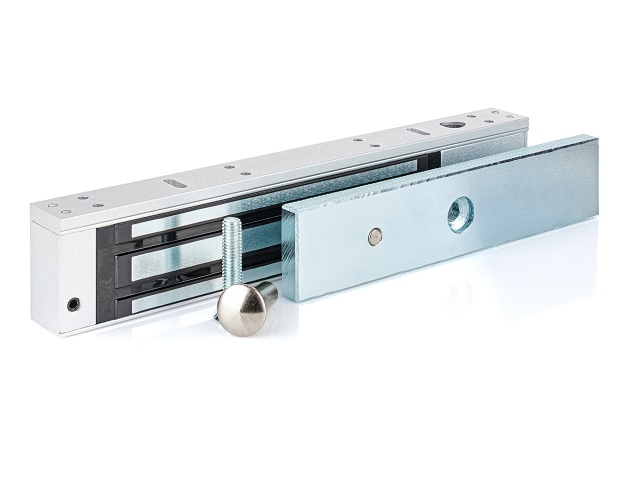How Maglocks and Electronic Strikes Secure Doors
31 August 2022

An Access control system secures the doors to a building, to ensure only authorised persons can use them for entry and/or exit. The hardware within a typical access control system will consist of one or more door controllers and readers (In/Out) and request to exit (RTE) buttons. The doors are secured by the access control system using magnetic locks or electric strikes and managed by an access control software platform such as EntroWatch.
What are Magnetic Locks or Maglocks?
A magnetic lock consists of a pair of fittings. An electromagnet that will be attached to a door frame, and an armature plate that will be attached to a door. A magnetic field is created by applying a DC power supply from the door controller to the door fittings. The magnet becomes energised and attracted to the door plate. The strength of the magnetism is determined by the size of the DC supply applied.
Maglocks are extremely secure and reliable. Typical maglock fittings can withstand a force (to open) from around 250kg up to 1000kg or more. As they require power to lock, maglocks can be set to fail-safe should there by an emergency or loss of power (including backup). This allows people to safely evacuate a building in an emergency.
Maglocks can be standard or slimline types. Slimline is the most commonly installed version, as the design offers a lower profile, ideal for narrow door frames. To attach the maglock may require a Z and L bracket or an L bracket dependent upon the doorframe and door. For an access control system, Maglocks can be unmonitored as the system will monitor door positions based on contacts and usage. Maglocks types also include monitored that can signal external devices as to their status (locked or unlocked).
What is an Electric Strike?
Electric strikes replace the fixed strike faceplate used on a door lock or latch. The strikes are connected to a DC (direct current) power supply from a nearby door controller. When the strike is activated, the latch is released and the door unlocks. When the door recloses, the strike automatically returns to the locked position.
What is the difference between Magnetic Locks and Electronic Strikes?
The primary differences between is their general power requirements and ease of fitting. Maglocks require power to lock a door. Without power present doors can be set to automatically open. This can be a feature set within the access control system software. Electronic strikes can be installed as ‘fail lock’ and ‘fail unlock’ types.
Maglocks are easier to fit as they attached to the door frames and doors. Electronic strikes can be harder to install and require a carpenter (‘chippy’) to assist with their fitting to a wooden door.
How Does An Access Control System Work with Maglocks
An access control system is configured to control entry and exit to specific doors within a building. Doors will include entry and exit points, as well as certain areas within the building. These areas may be under access control due to the need to restrict access to approved credential holders, track usage and movements, or to restrict numbers within a given area.
An approved user within an access control system will have one or more credentials issued to them. These can be traditional card or card/keypad credentials, mobile phone credentials carried within an App or biometric (fingerprint, face or eye).
Each access-controlled door will have an entry reader nearby. The credential is presented to a suitable reader and the credential checked by the management software in the user database. If approved, the maglock or electronic strikes are deenergised for a set time period and the door is unlocked. After a set time period the maglock or electronic strike is remagnetised and the door is locked. Exit back via an access-controlled doorway may be via a reader (credential presented) or a request to exit button (RTE). The same process of de-energising and magnetizing the door contacts or electronic strikes takes place.
Access Control System Design
When designing an access control system the starting point is to define the number of doors and their location. This not only determines the size of the system but can assist with choosing the door controller and how to install them to optimise door coverage. Door controllers from Remsdaq include 2-door, 4-door and 8-door controllers. The next stage is to review the types of doors which may be single or double leaf, entry or exit, fire doors and emergency exits. This then helps to determine how these doors are to be secured and the number requiring maglocks or electronic strikes. From this stage the design can then move onto determine the type of entry/exit readers required (card, keypad, mobile and biometric) and other features required from the access control system.
